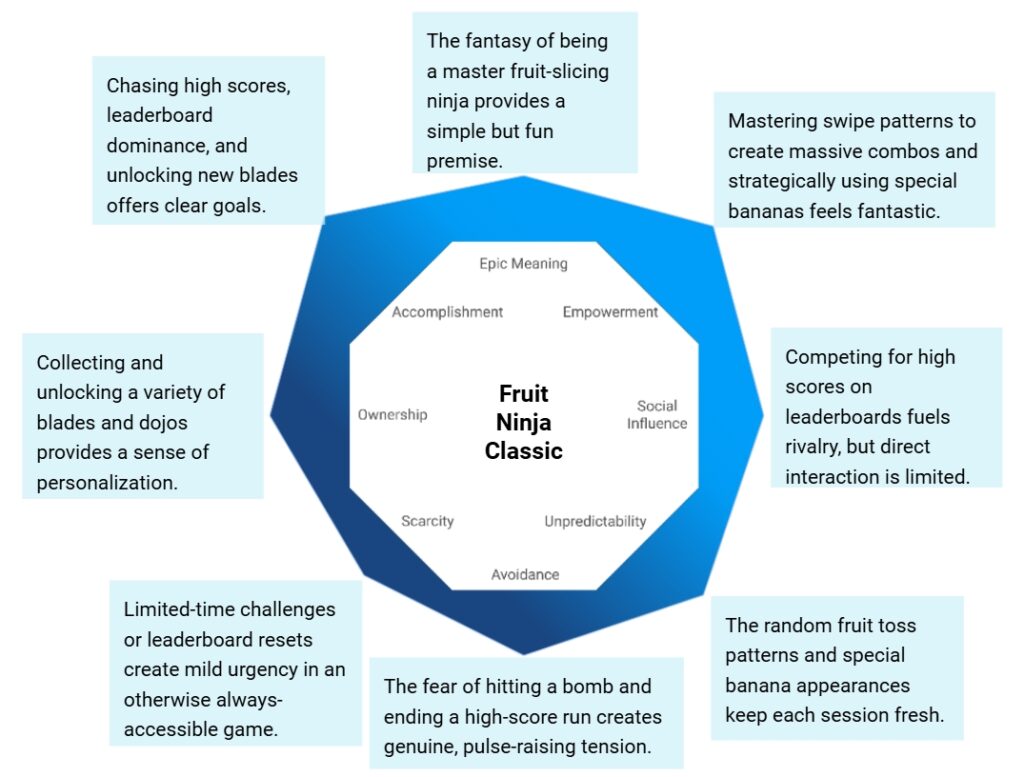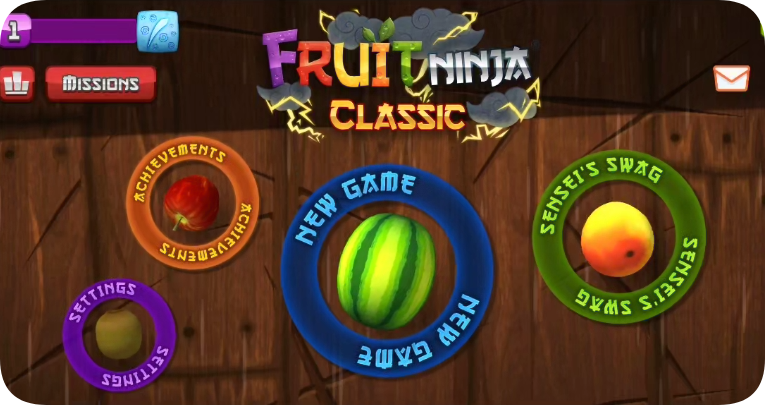Today, I’ll be using Yu-kai Chou’s Octalysis Framework to analyze why Fruit Ninja Classic remains an incredibly satisfying and enduring mobile game years after its initial release.
Octalysis Rating Table
| Core Drive | Score (1-10) | One-Line Description |
|---|---|---|
| Meaning & Calling | 5 | The fantasy of being a master fruit-slicing ninja provides a simple but fun premise. |
| Accomplishment | 8 | Chasing high scores, leaderboard dominance, and unlocking new blades offers clear goals. |
| Empowerment | 7 | Mastering swipe patterns to create massive combos and strategically using special bananas feels fantastic. |
| Ownership | 6 | Collecting and unlocking a variety of blades and dojos provides a sense of personalization. |
| Social Influence | 5 | Competing for high scores on leaderboards fuels rivalry, but direct interaction is limited. |
| Scarcity | 4 | Limited-time challenges or leaderboard resets create mild urgency in an otherwise always-accessible game. |
| Unpredictability | 6 | The random fruit toss patterns and special banana appearances keep each session fresh. |
| Avoidance | 5 | The fear of hitting a bomb and ending a high-score run creates genuine, pulse-raising tension. |
GScore: 276
Evaluation Notes:
Scoring range: 1–10. Higher scores reflect stronger implementation of the core drive and greater player motivation.
GScore (Gamification Score): Calculated based on the Octalysis Framework.
Octalysis Radar Chart

Detailed Analysis
1. Meaning (5/10)
The ninja theme does its job beautifully – it immediately answers why you’re slicing fruit instead of just matching colors. Those shurikens and dojos in the background aren’t just decoration; they’re cognitive shortcuts that make the simple act of swiping feel purposeful. It’s not Shakespeare, but it transforms abstract gameplay into a cohesive fantasy.
2. Accomplishment (9/10)
What separates Fruit Ninja from lesser mobile games is how it layers its rewards. Every swipe gives you immediate visual satisfaction, but also progresses you toward new blades, and contributes to your standing on three different leaderboards. I’ve actually abandoned high-score runs to strategically farm points for blade unlocks – when a game makes you willingly sacrifice short-term glory for long-term gains, that’s masterful design.
3. Empowerment (8/10)
The real game reveals itself after the initial novelty wears off. You start noticing that slicing bananas at specific angles yields better combos, or that letting single fruits pass sets up bigger chain reactions. This isn’t just testing reactions – it’s teaching spatial geometry under pressure. The difference between a casual player and a master isn’t speed, but the ability to see three moves ahead in a one-second window.
4. Ownership (6/10)
While new blades don’t change gameplay, they transform your relationship with the game. That “Dragonfang” blade you grinded for becomes more than pixels – it’s proof of your dedication. In a world of disposable mobile games, these permanent unlocks give your progress tangible weight.
5. Social Influence (5/10)
The leaderboard system captures the spirit of competition without the substance of community,that makes me dissapointed. You’re battling the ghost of your friend’s best performance rather than the player themselves. For a game about intense focus, the social experience feels oddly passive.
6. Scarcity (4/10)
In my point of view,the weekly leaderboard reset is scarcity done right – it creates natural conclusion points without punishing players. It’s the difference between “I should play before my spot drops” and “I can’t play because the game won’t let me.”
7. Unpredictability (7/10)
The genius lies in how the random fruit patterns force adaptation rather than memorization. Just when you think you’ve optimized your swipe pattern, the game throws a curveball that makes you reconsider everything. This variability is why the game still surprises me after all these years.
8. Avoidance (6/10)
The bomb mechanic transforms casual play into high-stakes drama. There’s nothing quite like the gut punch of watching a record-breaking run end because you misjudged one pixel in a fruit cluster. It’s not just about losing – it’s about protecting the effort you’ve already invested.
The Verdict: Why It Still Matters
The Enduring Magic: Fruit Ninja proves that great design transcends technology. It took one simple mechanic – the swipe – and built an entire universe around it. The satisfaction of a perfect slice remains as potent today as it was a decade ago.But,While the core gameplay is timeless, the social features feel stuck in the past. In an era of live tournaments and shared challenges, competing against leaderboard ghosts feels increasingly lonely.
Essential For: Anyone who believes mobile gaming should be about instant fun rather than endless grinding. It’s the perfect “five-minute fix” that respects your time while challenging your skills.


Leave a Reply